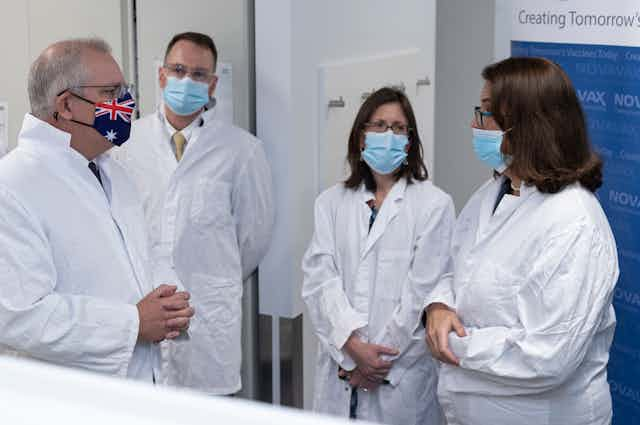Over the past few years, the Morrison government has made A$2 billion funding commitments to everything from the critical minerals and rare earths industry to bushfire recovery. Now the government has made yet another $2 billion announcement of an “action plan to supercharge research commercialisation”. It’s a longstanding challenge, one that many said should have been acted on long ago.
This announcement may appear like the many others that came before it, particularly given it’s so close to an election. Nonetheless, this effort may ultimately have an impact on one of the most vexing aspects of Australia’s economy: the lack of research commercialisation.
Read more: Our unis are far behind the world's best at commercialising research. Here are 3 ways to catch up
What is the plan?
Most of the money under the plan, some $1.6 billion, will go to a ten-year competitive funding program, “Australia’s Economic Accelerator”. The aim is to help university projects bridge the so-called “valley of death” between early-stage research and commercialisation.
The remaining parts of the plan include:
- $296 million for 1,800 industry-linked PhDs and 800 industry fellows over the next decade
- $243.5 million for the previously announced Trailblazer Universities program to create four university-based research and industry hubs around the country – eight universities have been shortlisted
- $150 million to expand CSIRO’s Main Sequence venture capital firm, which focuses on commercialising Australian research
- a new standardised intellectual property (IP) framework – providing more uniform IP licensing terms, clauses and agreements – to support more seamless university-industry collaboration.
Is this just another band-aid policy?
On the whole, Australian universities, businesses and science bodies have largely praised the announcement. That’s a fairly uncommon outcome in this increasingly contentious space where finger-pointing is ubiquitous.
If anything, the chief criticism thus far is that the effort is too little and too late for such a sizeable and consequential problem. After all, Australia’s record of research commercialisation remains one of the worst in the developed world. Yet we have world-class research facilities.
Facing a halving of international student numbers in Australia and a Commonwealth government that seemingly went out of its way to exclude the higher education sector from pandemic-related assistance, some may think universities should simply appreciate any help they can get. After all, this is the same government that cut $1.47 billion from the Australian Research Council over the past nine years.
Read more: Hit hard by the pandemic, researchers expect its impacts to linger for years
Yet, in reality, the $2.2 billion effort is unique not only for the size of the funding but also for its culture-focused reforms.
What’s different about this plan?
At the heart of the plan are steps to bridge the cultural chasm between two exceedingly different institutions: industry and the university sector. It’s perhaps the most important aspect of tackling lacklustre commercialisation.
The research culture of many Australian universities revolves around a mindset of publish or perish. This culture motivates the pursuit of PhDs to further academic knowledge. The focus ultimately prioritises publishing research over producing products and services that solve real-world problems.
The various global rankings of universities and the role of research in those rankings plays a key part in this mentality. A high global ranking enhances prestige, which in turn attracts students, so the logic goes. As a result, academics are encouraged to pursue both quality (highly ranked journals) and quantity (number of papers) in research.
Read more: Australian universities may be at a turning point in the rankings chase. So what next?
The most consequential impact of the Morrison plan may simply be the disruption of the publish-or-perish culture. The industry-linked PhDs, for example, would force often unwilling partners – industry and academia – to overcome cultural differences and work together on tackling problems.
Of course, there should always be room for blue sky research. However, more links with industry can make both the universities and individual researchers more oriented to practical solutions and commercial realities.
The Trailblazer scheme will create common ground for different stakeholders to work on mutually agreed goals. This process can nurture faith and confidence in each other’s abilities, leading to more productive practice-driven research.
The creation of a standardised IP framework may also help universities, particularly smaller ones with less administrative resources. The challenges of navigating the complex process of commercialisation can stymie collaboration with industry.
Read more: Who cares about university research? The answer depends on its impacts
Will this plan work?
The Morrison government plan’s proposal to change academic culture is an important step. But its success will depend on how effectively it tackles a mindset that underlies the publish-or-perish culture in Australian universities, and the intentions of the researchers themselves.
It would be a blunder to treat the diverse academic fraternity as one homogeneous group. Academics can have varying levels of motivation, some intrinsic and others extrinsic, that could drive them to become either a pure researcher or research-based entrepreneur.
The increased funding should be appreciated and will surely create incentives for universities to join hands to produce commercial products. But bringing about a change of heart is perhaps the first and more difficult step. The success of the government’s plan depends on it.

